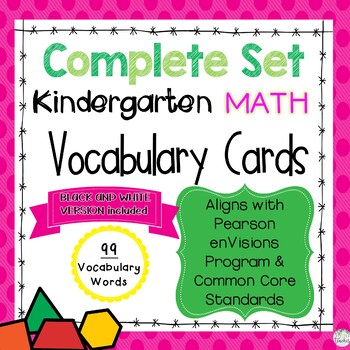Math Common Core and enVision Program Vocabulary Cards for Kindergarten
- PDF
Also included in
- This resource is for a whole-school or math coordinator who needs vocabulary cards for a math word wall. This bundle includes a set of color and a set of black and white vocabulary cards for each grade K-5. These cards align with the Pearson enVision 2.0 programs. You can use these cards as a resourPrice $45.00Original Price $59.00Save $14.00
Description
LARGE and clear math vocabulary cards for your Math Word Wall!
➯ 99 Color Vocabulary Cards and 99 Black and White Cards
➯ Aligns with Pearson enVision Program 2.0 for Kindergarten
➯ Color and black and white versions both included
Topics Included:
1: Numbers 0 to 5
2: Compare Numbers 0 to 5
3: Numbers 6 to 10
5: Classify and Count Data
6: Understand Addition
7: Understand Subtraction
8: More Addition and Subtraction
9: Count Numbers to 20
10: Compose and Decompose Numbers 11 to 19
11: Count Numbers to 100
12: Identify and Describe Shapes
13: Analyze, Compare, and Create Shapes
14: Describe and Compare Measurable Attribute
Topic 4 has no vocabulary cards
Great for bulletin boards and math centers!
Improves student learning of math concepts with GREAT visuals! Matches the program cards exactly.






